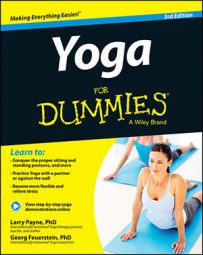Yoga offers a complete body and mind workout, with a complement of benefits you rarely find elsewhere. Yet as Yoga has become more popular, Yoga-related injuries have also become more common. With the proper intention and attitude, you can keep your Yoga practice safe and injury free.
Not everyone knows that some popular styles of Yoga originated from the training routines of athletic youths who preformed acrobatic Yoga shows around India. No wonder some forms of Yoga practice aren’t suitable for everyone! Fortunately, the true benefits from Yoga derive from the practice itself.
Avoid seeing Yoga as a competition— even with yourself
Yoga is not a competitive sport. Going beyond your limits makes you a prime candidate for an injury. Furthermore, one of the benefits of Yoga practice is the inward focus and sense of peace it brings; competition is a perfect antidote for inner peace. If you find yourself comparing yourself to the people around you during a Yoga class, bring your attention back to your own body and mind.
You can generally always find someone who’s more advanced than you and someone who’s lagging behind. And the truth is, it doesn’t matter how “good” or “bad” you are.
Listen to your body and be in the moment
Yoga is about the moment. It’s a meditation in motion. Listen to what your body and breath are telling you, and learn to adjust your practice accordingly. Is your breath choppy? If so, scale back your physical practice until your breath becomes even again. You’re not racing toward a finish line — and there’s no prize for whoever has the most body aches afterward.
Challenge yourself, don’t strain yourself
Whichever style of Yoga you choose, remember that Yoga is a “work-in,” not just a workout. While the more athletic forms of Yoga can be physically challenging as well as meditative, you need to find the line for you between challenge and strain — and then don’t cross it.
When you strain yourself in a pose, you’re more apt to suffer an injury. Working at your edge can be quite enjoyable and rewarding, but stay within sensible limits. Honor the reality that what makes sense for you and your body can — and will — vary with the time of day and from day to day.
Forget about what you used to do
Our bodies and physical abilities change over time. Generally, most people who are in their 40s, 50s, and older credit time with having had greater physical prowess. But time doesn’t have to limit your practice and experience of Yoga. In general, older practitioners tend to enjoy and benefit from practices with slower gentler movements and a greater emphasis on breath.
Don’t buy into “no pain, no gain”
That feeling of physical exertion at just the right level, where you find the sweet spot of alertness and comfort, can be exquisite. So go ahead and find your edge, and feel the joy of your body at work. But if you reach the point of a wince, or if your breath becomes rapid, it’s your direct message that you need to scale back a notch or two.
Choose function over form
How your posture looks in a posture isn’t important. Instead, you need to focus on how the posture benefits your body and mind. Try not to muscle yourself into the postures; relax into them. Don’t twist yourself into a posture your body is unhappy with — it’s a recipe for injury. Simple adaptations enable you to reap the benefits of many postures without crossing the line into unsafe practice.
When you focus on the function of a posture, you can see that you don’t need to achieve a perfect outward form to enjoy the benefits.
Find the intersection of focus and ease in your postures
The basic requirement for any Yoga posture is alertness or focus, and comfort or ease. If you keep this in mind, you can avoid injury. What’s “ease-full” for you may be very different from what’s “ease-full” for an adept practitioner. Knowing this, you can expect your postures to look different from the postures of someone with a long and advanced Yoga practice.
Seek out a Yoga teacher who respects your limits
Learn to recognize the difference between a teacher who encourages you to give it your best and one who tries to push you beyond your healthful limits. If your instructor is of the second variety, exercise your right to decide what you will and won’t do with your body in that class — and choose a different teacher next time.
Sometimes your own inner voice is the one pushing you beyond your limits. In those cases, refer back to the first tip: Yoga isn’t a competition, even with yourself.
Find your personal comfort zone
Your Yoga practice isn’t a one-way street. Imagine that the teacher gives an instruction to take the pose to the next challenging level, but you find that it’s too much for you. Well, you can change your mind. Work at the level that suits you best at that time, and give yourself a pat on the back for having been curious to explore just where that level is.
Give yourself the benefit of time and allow Yoga to unfold
Nowhere is it written that you must master certain Yoga postures to have a thriving and beneficial Yoga practice. If you hold on to an image of what a Yoga posture or practice should look like and push through regardless of warning signs that your breath and body are giving you, you’re bound to hurt yourself.
If you approach your practice with dedication and focus, as well as some loving-kindness for yourself, you can experience the benefits Yoga offers, regardless of which postures work for your body or how your posture looks when compared to the beautiful models on the covers of the popular Yoga magazines.

